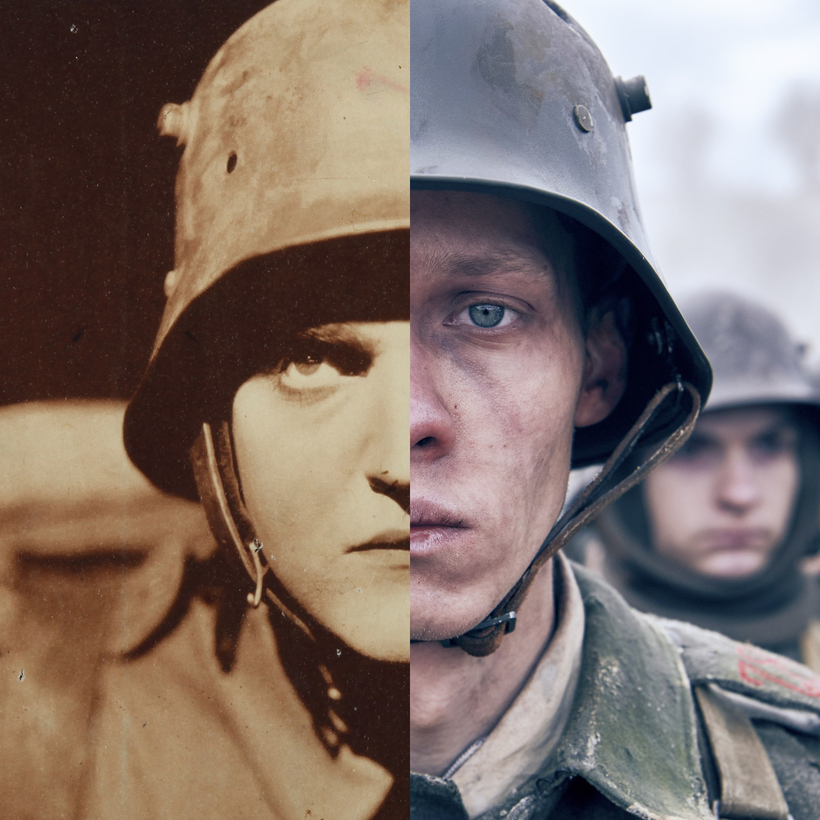After Edward Berger’s All Quiet on the Western Front, a feral adaptation of Erich Maria Remarque’s semi-autobiographical World War I novel, won a whopping seven BAFTAs, this awards-season long shot became Oscar’s top contender.
Last fall, film-festival press embraced that strung-out tease Tár and that beveled memoir The Fabelmans, but Berger’s dynamic images of European armies stalled in vicious conflict have an immediacy, topicality, and breadth that could not be denied. Berger’s movie, at its erratic best, cleaves to Remarque’s vision of men reduced to war waste.
Berger is a master of ruthless visual compression. Before the story proper begins, he follows a soldier’s progress from pitched combat to mass grave. We see the boy’s bloody, tattered uniform cleaned and repaired for the next recruit—who turns out to be our teenage protagonist, Paul Bäumer (Felix Kammerer).

After Berger swiftly establishes that men are mere cogs in the military machine, we spend two hours watching him re-prove it in fiendishly inventive ways. Images of bodies torn and torched recall both Picasso’s painting Guernica and Sam Peckinpah’s World War II film, Cross of Iron—a smash hit in Germany when Berger was growing up in Wolfsburg.
What Berger goes after and achieves is a supercharged audiovisual tapestry, with battle sounds amped up to 11 and a score whose synthetic thuds augment the aural carnage. Hand-to-hand combat with swords, bayonets, and spades and mechanized warfare with machine guns, tanks, and flamethrowers merge with hollering humans and ear-piercing whistles of bombs and missiles. Out of this warlock’s brew, Berger conjures an eerie and indelible experience.
As in every version of Remarque’s story (including Delbert Mann’s workman-like 1979 TV movie), soldiers live in crazy, zigzag battlements, bounded by bombs and gas above and mud and gore below. They battle rats, rot, and claustrophobia as they advance or retreat by inches through cratered landscapes. Outrageous violence becomes a fact of life (or death).

Berger and his co-writers (Ian Stokell and Lesley Paterson) unroll the action as if unspooling barbed wire, with bits and pieces of Remarque’s prose stuck to every other point. This film presses Bäumer into service during the war’s last 18 months; it erases his harrowing basic training, terrifying hospital stay, and despairing, alienating home leave. Without Remarque’s buildup and context, each fresh indignity or threat registers as a hyperbolic jolt, from bailing filthy, bloody water from the trenches to pulling on gas masks in six seconds.
Berger leaves no room for the incremental development of character. He cedes that space to flat, didactic scenes—not found in Remarque—about Germans bowing to French demands for an armistice that means complete surrender, and a loathsome Prussian general who, at dawn on November 11, 1918, announces one final attack even though peace will be declared at 11 that morning. Presumably this is what Berger means when, in interviews, he professes to tell the story from “the German perspective.”
After Berger establishes that men are mere cogs in the machine, we spend two hours watching him re-prove it in fiendishly inventive ways.
Lewis Milestone’s landmark 1930 Oscar winner (best picture and director) managed to do all that without special pleading or overkill. Unlike Berger’s in-your-face aesthetic, Milestone’s film displays a rugged, dramatic poetry. With trenchant tenderness it tracks the raw recruits as they resist dehumanization while learning how to summon their inner savage. His film pays off both as protest and tragedy.
Christopher Nolan stated, in 2017, that the “intensity and horror” of Milestone’s movie have “never been bettered.” I still agree. Milestone (who later directed The Front Page and Of Mice and Men) uses thrilling, innovative film-craft to embrace the full arc of Remarque’s story.
Near the start, schoolroom windows frame a patriotic village cheering on its troops. Milestone pulls his camera back into the room as a high-toned jingoistic schoolmaster exhorts his students to enlist—and the director cuts from their faces to the fears and fantasies that dance in their adolescent heads.

Throughout, Milestone jam-packs his master shots—deep-focus tableaux—with angular lines of parading soldiers and backslapping civilians or volatile layers of Red Cross railroad cars, horse-drawn caissons, shattered buildings, and, always, infantry double-timing through bombarded plains or streets.
His nimble and organic editing connects us to his characters’ psychologies. As Bäumer’s company dwindles, Milestone, in a burst of sympathetic imagination, zeroes in on a dead soldier’s deluxe boots adorning a succession of doomed men. During the first extended trench fight, he intercuts dug-in German machine-gunners with nightmarish traveling shots of Frenchmen falling in rapid-fire rhythm. We feel what it means to be “mowed down.”

In Milestone’s soulful climax, the heartbreaking young Lew Ayres as Bäumer, an amateur lepidopterist, reaches from his trench for a butterfly. A sniper aims and shoots, and Bäumer’s outstretched hand curls and crumples in a devastating close-up. The director then reprises and extends a shot of Bäumer and his mates looking backward as they trudge to the front. This time, they’re superimposed over a cemetery: as they advance into the dark, each in turn looks over his shoulder and stares toward us. The screen goes black for a full 12 seconds before Milestone prints “The End.”
The old All Quiet on the Western Front is a masterpiece. The new one, geared to contemporary sensibilities, is an immersive, kinetic epic in which the visceral trumps the lyrical.
Michael Sragow has been a film critic for Rolling Stone, Salon, and Film Comment, among other publications, and is the author of Victor Fleming: An American Movie Master

